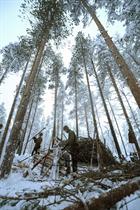Life in the Freezer
In 1968, following a winter in Norway where the limitations of HMS Bulwark’s (a Commando Aircraft Carrier) Air group were keenly exposed, Flag officer Naval Flying Training, ordered 846 Naval Air Squadron to conduct trials and training in an Arctic environment in order to improve the aviation combat support provided to 3 Commando Brigade (3 Cdo Bde) Royal Marines. The NATO Northern Flank reinforcement plans, in which 3 Cdo Bde played an essential part, identified the Royal Norwegian Air Force Base (RNoAF) at Bardufoss as a key area, and it was here that the arctic training came to be centred.
RNoAF Bardufoss is located some 200 miles inside the Arctic Circle at 69 degrees north and sits across the E6, the only road to run the length of Norway. The training cadre (known as JHC Clockwork) has deployed each year to Bardufoss to conduct Mountain and Cold Weather Warfare training. The area provides excellent training areas for both aircraft and personnel and an effective logistic supply routes by road and sea.
The current training programme consists of three major elements – survival, military training and Arctic flying. The terrain around Bardufoss provides the ideal environment, providing not only the harsh Arctic settings with temperatures plummeting to as low as minus 35 degrees, but also a mountain flying area with peaks rising to 5000 ft along with sheer-sided valleys and low-level navigation areas.
Weather conditions can change rapidly over a short period of time; this can catch out those who are unwary, ill-prepared, or badly trained. For these reasons it is mandatory for all JHC personnel of all ranks to undertake the seven day Cold Weather Survival Course (CWSC) before they can deploy into an extreme cold weather (ECW) environment and operate and live safely in such arduous field conditions.
Taught by the Royal Navy’s elite Royal Marines Mountain Leader cadre who are specialists in extreme cold weather environments, students spend the first two days of the course in the lecture room and familiarizing themselves with the vital and potentially life saving equipment they will be using in the field phase of training.
Day one in the field students learn how to move and navigate across the Arctic terrain often having to find paths through deep snow drifts carrying full Bergens (Rucksacks) on snow shoes these Bergens which can weigh up to 30 kgs. The first evening is then spent in 10 man tents; this gives those individuals who have little or no field experience a chance to brush up on their personnel administration (looking after their personal cleanliness and kit) which is an essential part of CWSC.
Day two consists of navigation exercises, practical demonstrations on avalanche drills as well as learning how to construct and camouflage a four-man tent position which will be home for the second night.
Days three and four represent the survival side of training with day 3 spent building a snow shelter or ‘Quinzee’ a labour intensive job involving piling up to one and a half tonnes of snow into a mound before tunnelling an entrance and sleeping area into the centre. This becomes home for the evening bringing new meaning to words ‘life in the freezer’ although surprisingly at a cosy 0 degrees inside; this will be the warmest night spent outside.
The fourth and final night is spent below the tree line in the woods surrounding the old German second world war airfield. Here, left only with the contents of their pockets and a survival knife, students learn to construct shelters from the trees in the form of a brushwood bivvy.
The final day brings the infamous and often dreaded ‘Ice Breaking Drills’, which involves each individual jumping into a snow hole cut into a frozen Norwegian lake fully clothed whilst carrying their Bergen, the students then have to dig deep using all their mental and physical strength to pull themselves clear of the icy water.
For the aviators, aircrew training consists of a series of lectures as well as around 25 flying hours per pilot and air crewman dedicated to general Arctic-flying training. The course covers a full range of subjects including landing techniques in re-circulating snow, load lifting, embarkation and disembarkation of troops, landing on mountain peaks, navigation and formation flying in daytime and at night using night-vision goggles (NVGs).
This extreme cold weather environmental flying training not only prepares aircrews for flying in Arctic conditions but also provides valuable pre-deployment training for operations such as Afghanistan. Flying techniques used to overcome “white-out” conditions caused by heavy re-circulating snow are very similar to those used for desert “Brown-Out” conditions.
Lt Cdr ‘Spidey’ Clarke RN the Senior Training Officer at Bardufoss explained, “Operating in the Arctic winter is a matter of applying specific techniques to overcome a hostile environment, those undertaking flying training soon realise that what they experience at ‘Clockwork’ will probably be the most testing conditions they will ever encounter. If they can operate effectively here they can do so anywhere. It will also develop the Royal Navy’s core values of Team Work, Strong Leadership, Commitment, Courage, Discipline, Respect for Others, Integrity and Loyalty.”
During the 2012/2013 winter’s training period CHF and JHC personnel will have completed extreme cold weather survival training. These range from Royal Marine Commando’s to Navy Chef’s, along with 15 pilots and air crewman who additionally complete Arctic flying training.
The rigours of annual mountain and cold weather survival and combat flying/field training 200 miles within the Arctic Circle enable CHF aircrew and support personnel to work in complete unison with members of 3 Cdo Bde and to cope with exigencies of Commando flying operations, aircraft maintenance, self support and point defence in the field in extremes of climate and mountainous terrain, without cause to rely on a 3rd party for assistance. Once again ‘Clockwork’ provides a relevant and highly valuable training environment for those on current Ops and on standby for Contingent Operations.





